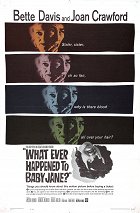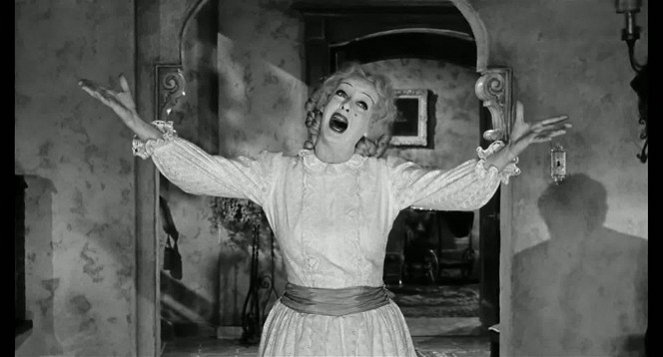Ohjaus:
Robert AldrichKäsikirjoitus:
Lukas HellerKuvaus:
Ernest HallerSävellys:
Frank De VolNäyttelijät:
Bette Davis, Joan Crawford, Victor Buono, Wesley Addy, Julie Allred, Anne Barton, Marjorie Bennett, Robert Cornthwaite, Anna Lee, Maidie Norman (lisää)Juonikuvaukset(1)
As a child, Jane Hudson (Bette Davis) was a pampered vaudeville star known to the world as Baby Jane while her younger sister, Blanche (Joan Crawford), led a quiet life in her considerable shadow. Decades have passed and now Blanche is a beautiful, talented movie idol and Jane a lowly extra. When a car accident cripples Blanche, binding her to a wheelchair, Jane sees her opportunity for revenge and assumes the role of caretaker. Her newly gained power completes the transformation of the sugar-sweet child star into a nightmarish caricature of Baby Jane. As she does everything she can to make her sister's life a living hell--including feeding Blanche a dead rat and brutally beating her when she tries to phone for help--Jane plots a comeback, aided by shifty musical director Edwin Flagg (Victor Buono). (jakelijan virallinen teksti)
(lisää)Videot (1)
Arvostelut (5)
Solid psychological stew with a rather novel horror feel, certainly one of Stephen King's main sources of inspiration when later writing “Misery”. You just don't see a sisterly relationship this heated, and I'm honestly surprised that the film stands so far out of the audience's interest. The only weaknesses I can see are the weird ending, the slightly excessive runtime and the fact that Bette Davis is such a disgusting hag that it was almost impossible to watch her; as an actress, however, hats off. 80%
()
A great horror psycho-thriller about two ageing actresses that is brought down a little by a few screenwriting blunders (did they really have to throw the paper with the message through the window, wouldn’t it have been enough to cry?), but they are easy to overlook. Bette Davis’s performance is chilling, her portrayal of the disturbed Baby Jane is amazing. Something between Misery and Sunset Blvd.
()
The film to which the Feud: Bette and Joan (2017) series made a monument. The meeting of the two former stars is interesting, and the shift into a different genre, which was unusual before the war, is also interesting. The masks are excellent, and so is the retrospective reception of classic films shown on television after thirty years. But that's about it. The post-war discourse about us doing it better and them doing it naively or stupidly or uninterestingly before is literally comical. It's hard to measure a quality melodrama with hysterical horror about lost illusions.
()
I often forget that movies from 1962 still look like they were made in 1942, and I admit I was never a fan of those theatrically lit studio interiors and nonstop orchestras playing in the background. In this case, the threadbare script grates a little, too, making the garage by the house practically its own character who will pop into the plot at any moment to thwart one of the heroines' efforts at deliverance. But hey, I'm letting it slide because Baby Jane is such a wonderfully imagined, creepy, and still relevant horror character. She mixes personal trauma with pure terror so well that this monster deserves to stand proudly alongside the canonical horror characters she's compared to, but one other thing – the well-paced development of her character from spoiled little girl, to incompetent but tolerated actress, to boozy old rascal clinging ever more closely to her childhood glory. Then when fifty-five-year-old Bette Davis tries to reawaken her learned childlike cuteness through five pounds of makeup, you might as well dial your therapist.
()
“Who the hell was Baby Jane Hudson?” For her, life is theatre. If she isn’t at the centre of events, it’s as if she doesn’t exist. She is also convincing in her new role as a tormentor thanks to the fact that the victim of her (domestic) violence is her own sister, a woman who dared to be more famous. Just the two of them, a large house and the memories in which Jane is imprisoned, just as Blanche is imprisoned in the house (and just as her bird is imprisoned in its cage). Memories of past fame and of a time without television, when the public’s admiration was more valuable than money. And of a father whose authority is newly embodied by Jane herself. Jane will not admit that she has to share favours, especially of the male variety, with her sister, whom she physically abuses particularly at the moments when she feels threatened by a man. Whether it’s Edwin, fixated on his mother like Jane is on her father, or the doctor with his white coat buttoned up to his neck, reminiscent of a scientist from a monster movie due to an overhead shot. ___ Despite the explanatory prologue, however, it is not clear who created the monster called Baby Jane. We don't know enough about the female protagonists to understand the incredible cruelty of one and the partially voluntary passivity of the other. (The claim that the former is a sadist and the latter a masochist makes sense, but is not based on what the film tells us.) Though more straightforwardly shocking than satisfying, the explanation comes just before the end, which, unlike the rest of the film, takes place in an open area, thus escalating Blanche’s helplessness to the limit of tolerability (freedom is within her grasp, and yet she can't reach it). ___ The deficiencies in the psychological profiling of the protagonists and the suspension of plot development in the final third may not be noticeable at first because of the impressiveness of Aldrich’s directing. He combines theatrical stylisation (frontal room shots, lights placed in the foreground, campy makeup) with purely cinematic means of expression (a zoom lens, unconventional angles) while being well aware that the backbone of his psychological monster horror movie (which, unlike classic monster flicks, doesn’t conceal the fact that the titular monster is actually a female person) comprises two Hollywood divas. (Depending on how you look at it, Baby Jane can also be described as, for example, a grand guignol, gothic horror or camp obscurity, but I searched in vain for signs of black comedy in it.) Both of them overact because that was their style (which was already outdated in the 1960s) and because they can. The roles allow it. To be themselves, great actresses. Sincerely and painfully. 80%
()



Mainos